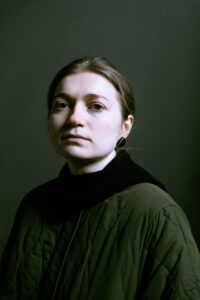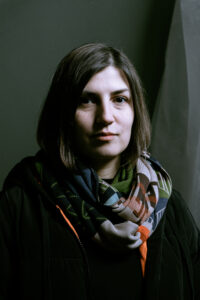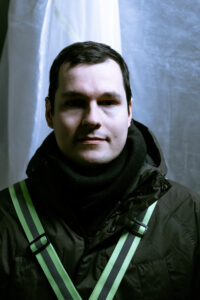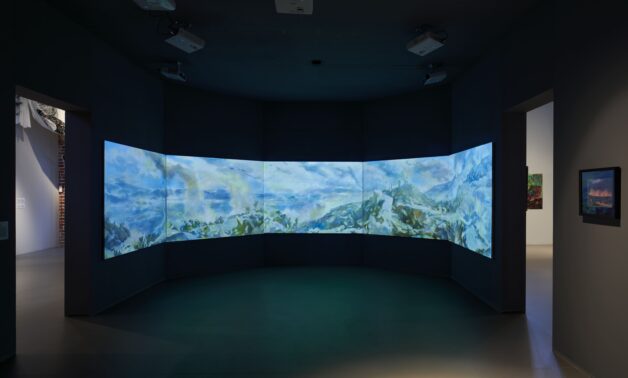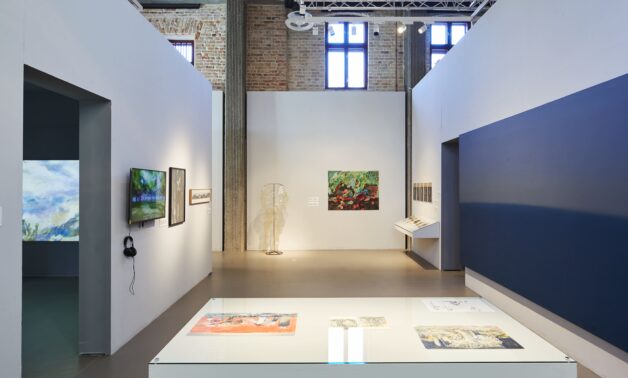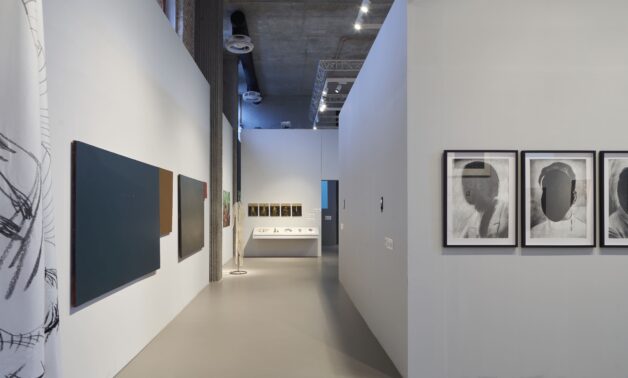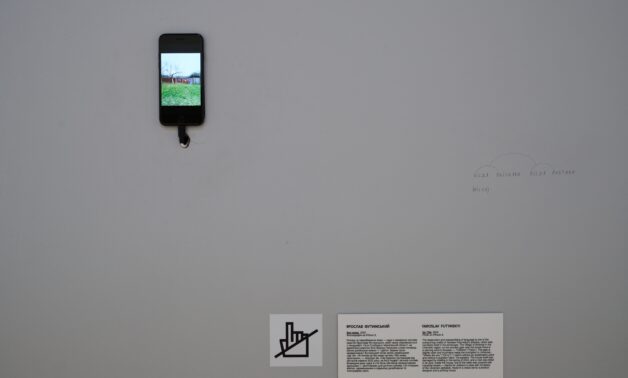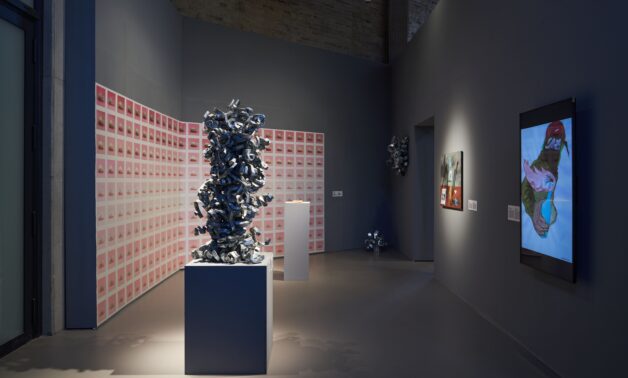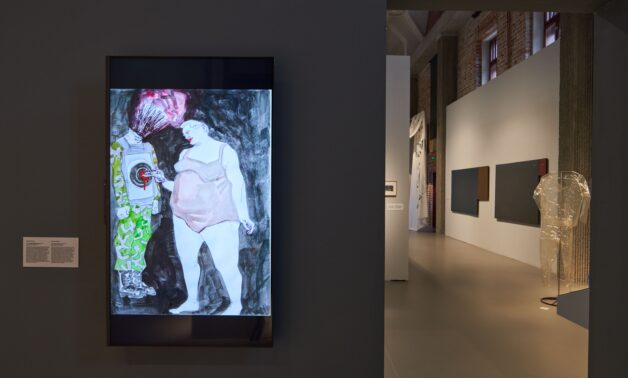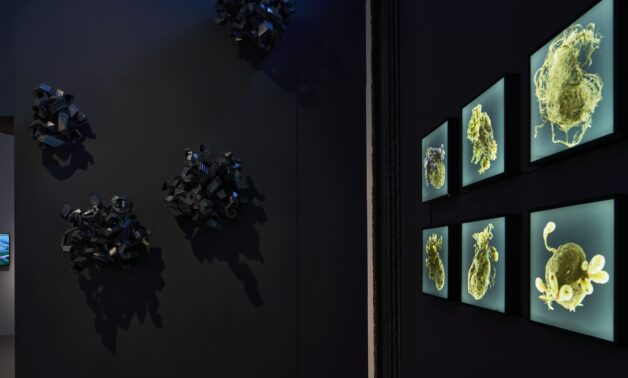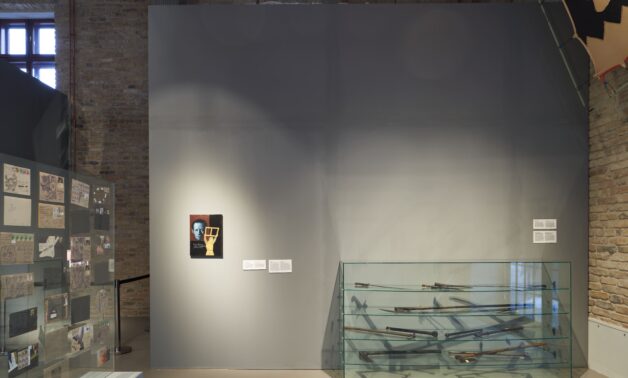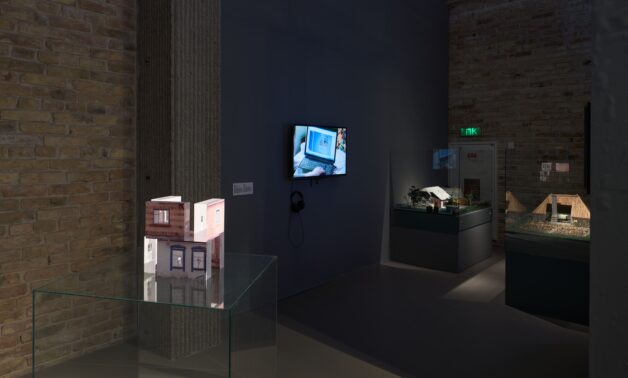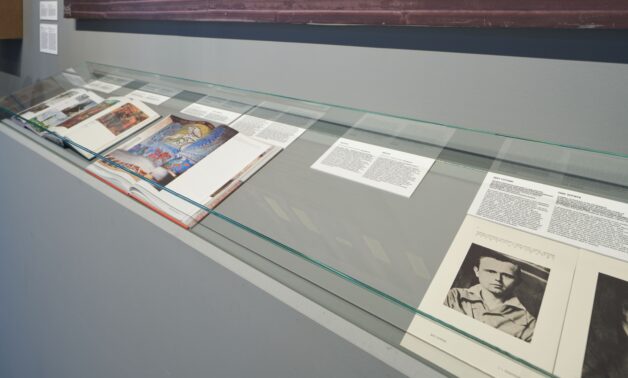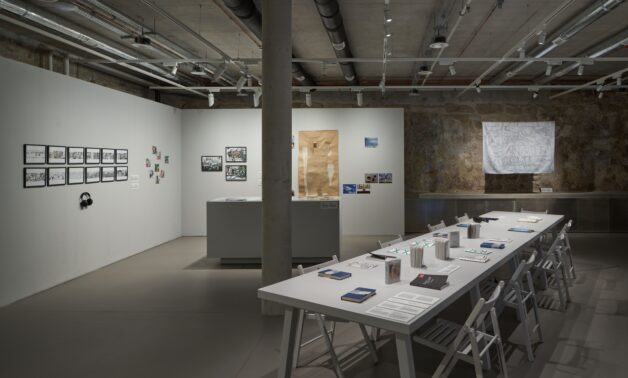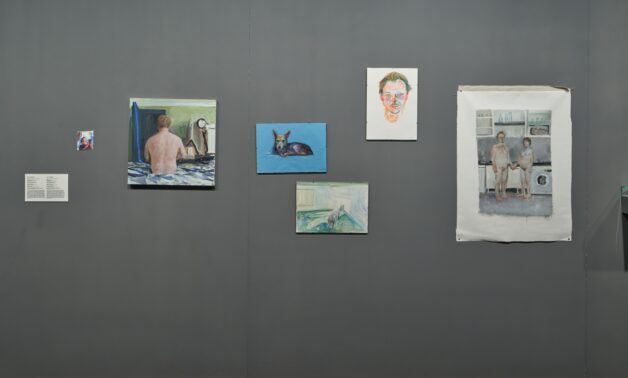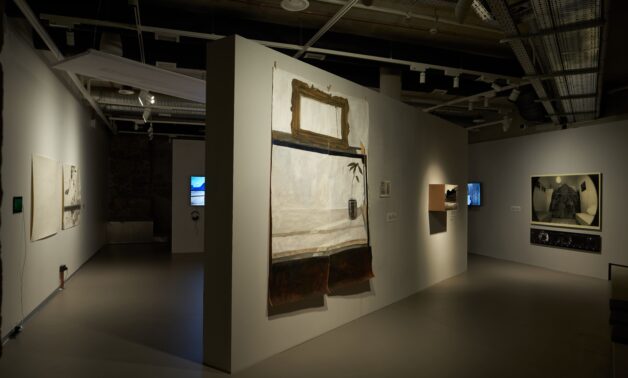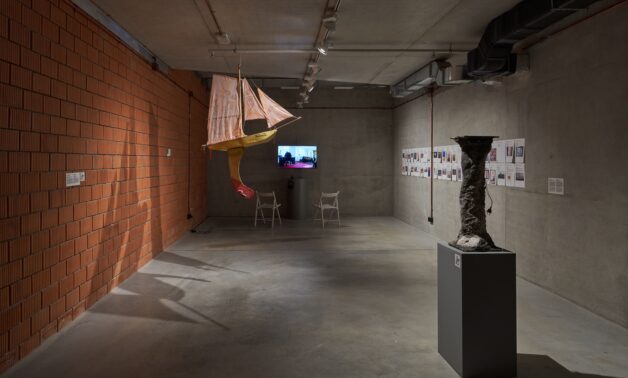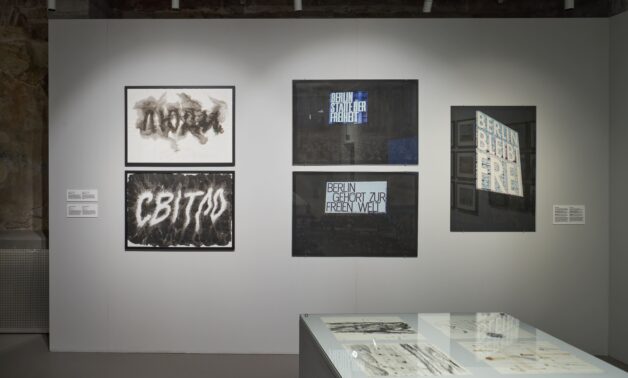The exhibition “Our Years, Our Words, Our Losses, Our Searches, Our Us” accompanied the opening of the art center on November 18, 2023 and was the first large-scale exhibition in the history of the Jam Factory Art Center. The exhibition presents the works of Ukrainian artists from 2022-2023 and a longer chronology – from the 19th century to the present. We invite you to learn more about the exhibition concept, formed by the curatorial group of Kateryna Iakovlenko, Natalia Matsenko, and Borys Filonenko.
Our Years, Our Words, Our Losses, Our Searches, Our Us
A curatorial introduction
This exhibition began to take shape as we grappled with language. When the three of us first broached the theme of “art during wartime,” its contours were expectedly hazy and the words that seemed appropriate eluded us. Over the past year and a half, we have often had to stop in the middle of our conversations to define the part of the war that began on the night of February 24, 2022, or, conversely, interrupt our confident speech in order to extend the chronology of the invasion to at least 2014. Ukraine’s struggle for self-expression, independence, and ultimately existence unfolds further back in time: five in the morning became a temporal rupture that first drew in Crimea, then Donetsk and Luhansk, and now the entire country into the long twentieth century – with its unfinished wars, local and international politics, landscapes, languages, weapons, museums, emancipatory movements. By looking beyond the twentieth century, we can see the burning fields in Taras Shevchenko’s works, which continue to smolder before our eyes. This is how we also notice our own perspective, which now views the art of the past differently.
The exhibition “Our Years, Our Words, Our Losses, Our Searches, Our Us” is based on the convergence of two perspectives: one that reaches back to the artworks created before the 2022 invasion, while the other that engages with contemporary viewpoints. Looking at each other and into the past, we question change and doubt, the reasons to conclude or suspend artistic practices, and the ability to initiate them. Can doubt become a method? In these two temporal streams, historical and personal, in the disordered and radical times, we have arrived at the point where we do not provide definitive definitions, but create paths to follow artists in their transformations and connections with each other. We have constructed the exhibition in such a way as to tell almost the same story multiple times – at the intersection of two scopes, grounding ourselves where the distance between history and personal experience is shortened.
In this war, it becomes clear that the proclamation of the twentieth century as a short one (1914-1989/1991) was premature. History does not end but continues. The era that remained in the past for some time, which could only be excavated, is now scaled into a “very long twentieth century” (? – to the present), compared to the duration of the rather long nineteenth century (1789–1914). In this expanded horizon of events, the empty spaces of history receive explanations not only through research studies, but primarily through the lived experiences of participants and eyewitnesses. In the changes accompanying these experiences, distances also shorten. In the formation and maintenance of connections, in building temporary artistic and non-artistic communities, within or beyond Ukraine, artists find a new present. Has the long chronology of the war become this new present? What was once an empty space is now being filled with an understanding of other experiences that resonate with our own. A continuous battlefield view of history unfolds between the Crimean War, its Soviet commemoration, the fall of the Iron Curtain, and the current war, where Crimea has become one of the cornerstones. Forgotten potatoes and the monument to Kherson potatoes lead to famine and harvest in the artworks of the twentieth century. Portraits of friends at an art residency meet painted-over faces from a 1930s photo album. Portraits taken by a half-frame camera blend with friendly caricatures from the gallery of portraits of participants of the Second Congress of the Ukrainian Union of Proletarian Writers. An empty space for the icon of the Vyshhorod Mother of God is replaced by black paint made from scratch from soil, forming a Suprematist icon. Gaps in understanding and archiving of the past are accompanied by the current emptiness of evacuated museums. Dioramas, landscapes, 360° panoramic VR videos, video archives of the heavens, inaccessible territories of personal geography. Diaries, anthologies and periodicals. A memorial of 2021 meets a memorial of 2023.
The empty spaces in the long chronology of the war not only indicate gaps and mark absence, but also become counterforms, revealing newly noticed significance. Conscious emptiness is no longer the emptiness of forgetting. For us, emptiness is a reason for reflection, a space for exploration and movement, a perspective from the past to the future and vice versa. These voids do not appear by themselves: stolen, lost, banned, unpublished, destroyed, evacuated works of art; shot-at murals of Boychuk followers, the concrete-filled “Wall of Memory” by Volodymyr Melnychenko and Ada Rybachuk, mosaics of the Sixtiers shattered by hammers and missiles, and so on. Gaps and losses tend to be filled. They are bridged and intertwined by living ties that form rapidly and non-linearly, in contrast to the monolithic narratives into which time and ideology seek to compress history.
In defining the curatorial gesture, we quickly abandoned the idea of creating a summarizing exhibition. First, the processes we are in the middle of are still ongoing, and second, the formulation of a generalized statement always arouses suspicion, primarily because of the oversimplification. This exhibition is structured like a series of essays – short and long. Each segment of the journey tells stories that can intersect and together form more complex essays. You can navigate this exhibition in various ways: starting from any essay, sequentially or chaotically, from the five rooms on the underground floor to the large space on the ground floor, or vice versa. With this variability, we aimed to capture the multiplicity of perspectives and experiences of this war, because despite certain collective experiences, each person lives it in their own way. There is no single answer to the numerous questions, no single route to follow. As always in history, which unfolds here and now, there is a personal choice and the ability to decide which direction to take. In the multiple paths of the upper hall, alongside the historical narrative, echoes of the essays from the lower halls emerge – about places and care, about loss and memory, about the language of love and the language of weapons. In the exhibition space, through a combination of the collective and the personal, we would like to talk about how our social structures are changing, how the sense of closeness, empathy, and love is transforming; what the relationships between people are like during the war, not only among community members, but also among the closest people, relationships among artists, between artists and curators, art and the viewer, art responding to specific tragic events and its presence over many years. The principle of essays, borrowed from the likes of Hrytsko Chubai, Kira Muratova, and Jim Jarmusch, allowed us to build trajectories along the paths that the artists themselves follow, doubting and showing solidarity in their actions and reflections.
The journey to follow the artists is evident in the exhibition’s title, extending the sequence started by the Prykarpatskyi Theater collective in their workshop “Our Apartments, Houses, Cottages, Garages, Offices, and Backyards” (2022). The recurrent “ours” isn’t a statement of ownership, but an invitation to perceive it not merely as appropriation, but as a newly discovered commonality. This commonality is the tangible condensation of life in the long war, which makes the exhibition primarily a meeting place, a space for sharing experiences and thoughts. Time and time again, practices of the communal are repeated and developed in artistic and non-artistic gestures: grassroots volunteer initiatives, postcards for donations, chronicles of self-organized reconstruction, images of interaction and encounters, images of forced displacement and separation, landscapes of tragedy that are quickly recovering or still beyond recovery. Commonality and community become tropes of the struggle for simple coexistence – when bodies are in the same place, thus forming an extraordinary gesture and resistance.
We do not enter the exhibition halls to tell the story from the very beginning. We are not concluding what we bring together in our temporary curatorial association. In fact, our narrative continues, commencing from our inaugural exhibitions, crafted by each of us individually at different times and in different contexts; it encompasses the experiences of fellow authors who also created or participated in exhibitions over the past year and a half. We construct paths and will gather together for several months to discuss the personal and communal, memory and history, hoping that the narrative will not be interrupted again.
Artists
Kateryna Alііnyk, Yehor Antsyhin, Yuriy Biley, Yuriy Bolsa, Katya Buchatska, Open Group, Vlad(a), Stas Voliazlovskyi, Stas Voliazlovskyi and Ilіa Isupov, Oleksandr Hnylytskyi and Oleg Holosiy, Yevhen Hulevych, Yulіa Danylevska, Andriі Dostliev and Lіa Dostlieva, Timur Dzhafarov (John Object), Anna Yeresko and Olena Zashko, Yuri Yefanov, Oleksandr Zhukovskyi, Dmytro Zaiets and Tetіana Pukhnavtseva, Bohdana Zaiats, Anna Zvyagintseva, Lucy Ivanova, Nikita Kadan, Zhanna Kadyrova, Alevtina Kakhidze, Alevtina Kakhidze and Pіotr Armianovski, Olіa Kowal, Svіatoslav Koverzniev, Vlodko Kostyrko, Mykola Kolomiiets, Vitalіy Kokhan, Yuri Leiderman, Pavlo Makov, Sasha Maslov, Mykola Matsenko, Kristina Melnyk, Sevilya Nariman-qizi, Natsprom (Oleg Tistol, Mykola Matsenko), Daniil Nemyrovskyi, Yevgen Nikiforov, Sergіy Petlyuk, Yuriy Pikul, Polina Polikarpova, Vіacheslav Polіakov, Sofia Pomogaibo, Georgiy Potopalskyi (Ujif_notfound), Prykarpattian Theater, Vlada Ralko, Andriy Rachynskyi, Daniil Revkovskiy and Andriy Rachynskyi, Andriy Sahaidakovskyi, Anton Saenko, Anton Saenko and Yaroslav Futymskyi, Vasyl Sai, Oleksiy Sai, Yevhen Samborskyi, Tiberiy Silvashi, Karina Synytsia, Dan Sotnyk, Elena Subach, Oleksandr Surovtsov, Lubomyr Tymkiv, Vasyl Tkachenko, Yaroslav Futymskyi, Roman Khimei, Dasha Chechushkova, Taras Shevchenko, understurctures.
Public Program
CONVERSATION “CULTURE AND RECONSTRUCTION: SUPPORT AND CREATION OF CULTURAL COMMUNITIES DURING WARTIME”
November 18th 2023
A moderated discussion with guest speakers took place as part of the opening of the Jam Factory Art Center.
Questions regarding the role of culture for Ukrainian civil society arise anew with each major challenge: the 2014 revolution, the annexation and the start of Russia’s war against Ukraine, the full-scale invasion in 2022, and various reconstruction projects of different scales and scopes. These challenges reopen questions about what cultural institutions should or could be, the transformations that cultural practitioners undergo during a state of
permanent challenges and change. The talk on the opening day of the Jam Factory will touch upon issues such as why culture often finds itself on the fringes of reconstruction thinking, why it’s essential to support culture and establish new institutions during wartime, what role institutions can play in cultural partnerships and mutual support, the essence of cultural community/communities, and how to support it/them, and when we can say “we”
and when can we say “ours” in the field of culture.
Moderated by Lizaveta Herman
Speakers: Andrii Linik, Alona Karavai, Yurii Kruchak, Illia Zabolotnyi, Liuba Ilnytska
DISCUSSION “ARCHIVE IMPULSE, EXHIBITION BALANCE”
February 10th, 2024
A discussion about the relationship between archiving and exhibition curation, as well as the new qualities and challenges of these practices.
Since the beginning of the full-scale invasion, working with archives, preserving, and documenting artistic practices have become urgent and self-evident. At the same time, the exhibition as a medium of artistic and curatorial practices immediately found itself in the zone of doubt, under thorough scrutiny regarding the expediency, methods, and intentions of certain exhibition statements. The trajectory that could depict the history of exhibitions in Ukraine after February 2022 would be quite uneven and would record periods of closing art centers and galleries, intensive periods of openings and restarts of programs, up to the present moment of fluctuations between relative normalization of rhythms and permanently-alerted states.
Moderated by: Borys Filonenko.
Speakers: Natalia Chychasova, Vitalii Matukhno, Olia Honchar
DISCUSSION “LOST AND GAINED: TRANSFORMATION OF CONNECTIONS IN COMMUNITIES 02.24.22-02.24.24”
February 24th, 2024
Since February 24, 2022 relations in artistic and non-artistic communities, their experiences, orientations, and activity principles have undergone significant transformations. From the perspective of almost ten years of the war and exactly two years from the onset of its full-scale phase, it is already possible to record not only significant changes but also a certain duration of the processes and differences of the current situation from the time of the beginning of the invasion. On February 24th, 2024 we will talk about how communities break apart and reassemble, how connections are lost and built anew, how the artistic sphere flows into non-artistic spaces and vice versa, and how artistic practices are combined with activism and volunteerism. We’ll talk about artists in the military, about how different experiences and memories coexist, and where the “common” arises or disappears.
Moderated by: Natalia Matsenko
Speakers: Stas Turina, Olia Marusyn, Bohdan Bunchak, Katia Rusetska.
CONFERENCE “EMPTY SPACES, BLANK WALLS, BLACK SPOTS, CHARRED FACES”
March 9th, 2024
Conference on Art History, archive, memory, museum, and the lost names and destroyed works of art.
This time, the curators suggest focusing on empty spaces, reflecting on what this void is filled with and how voids shape a narrative and tell a story that is silenced, forgotten or forcibly erased. And how even minor elements when they are found can change the story. This conversation is about courage and the ability to see in the dark of history, even without a night vision device.
Moderated by: Kateryna Iakovlenko
Team
Program and executive director: Bozhena Pelenska
Operations and executive director: Tetiana Fedoruk
Management: Yuliia Sapiha
Communications: Mariia Shvets, Yuliana Chorna
Financial support: Rymma Hladka
Design: Katya Drozd
Venue Manager: Levko Pidzharyi
Exhibition architecture: ФОРМА
Technical management and exhibition installation: Metamuseum
Visit the exhibition
- The ticket cannot be returned or exchanged.
- Reimbursement of the ticket is possible only if the event is canceled or postponed.
- You can use the ticket only once. If you have left the exhibition space, the validity of the ticket ends.
- Staying in the Art Center while under the influence of alcohol or drugs is prohibited. Visitors who violate the established order will be forced to leave the territory of the Art Center without a refund of the ticket price.
- During an air raid alarm, it is mandatory to use the shelter of the Art Center. Only the exhibition halls located in the basement will be open.
- Personal belongings can be left in the lockers.
- Come to us with your children.
- Please do not enter the exhibition with food, drinks or pets.
- Photography and video recording are allowed, except for private photo sessions.
- Visiting the exhibition by large groups is possible by prior reservation.
Curators
